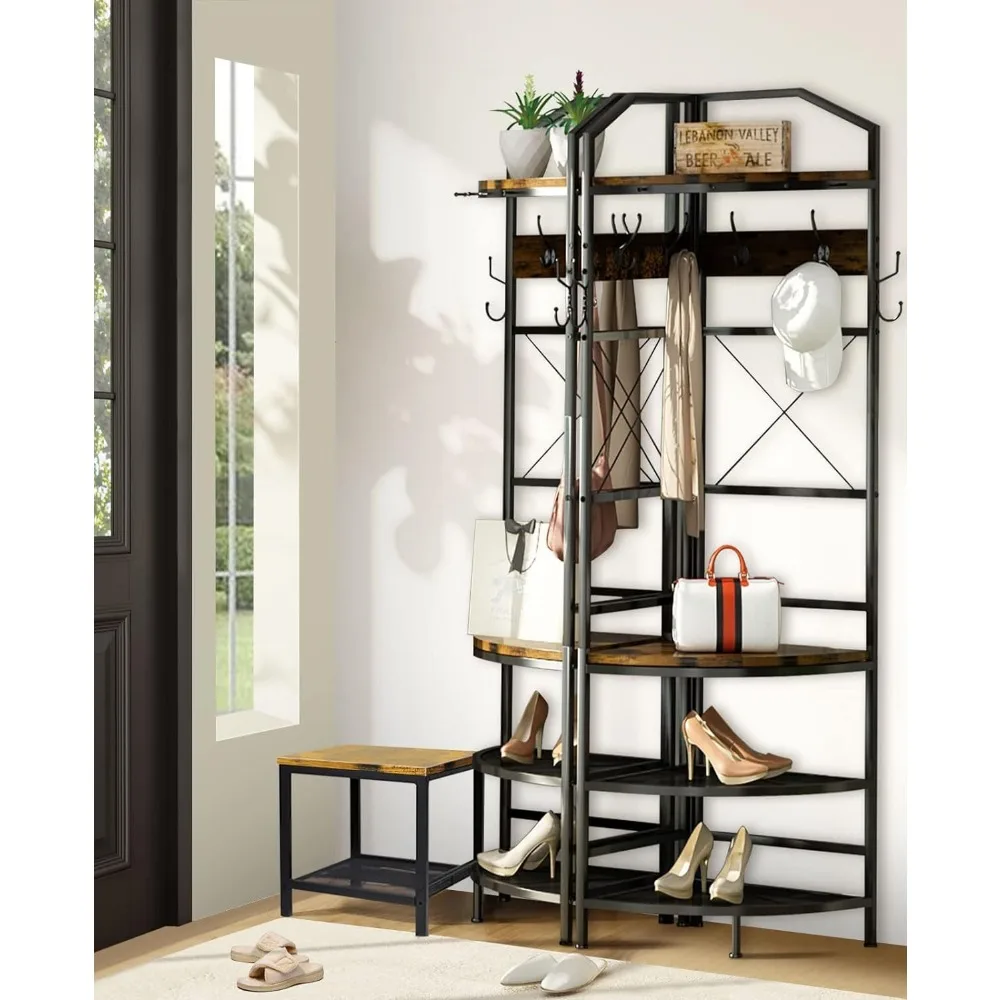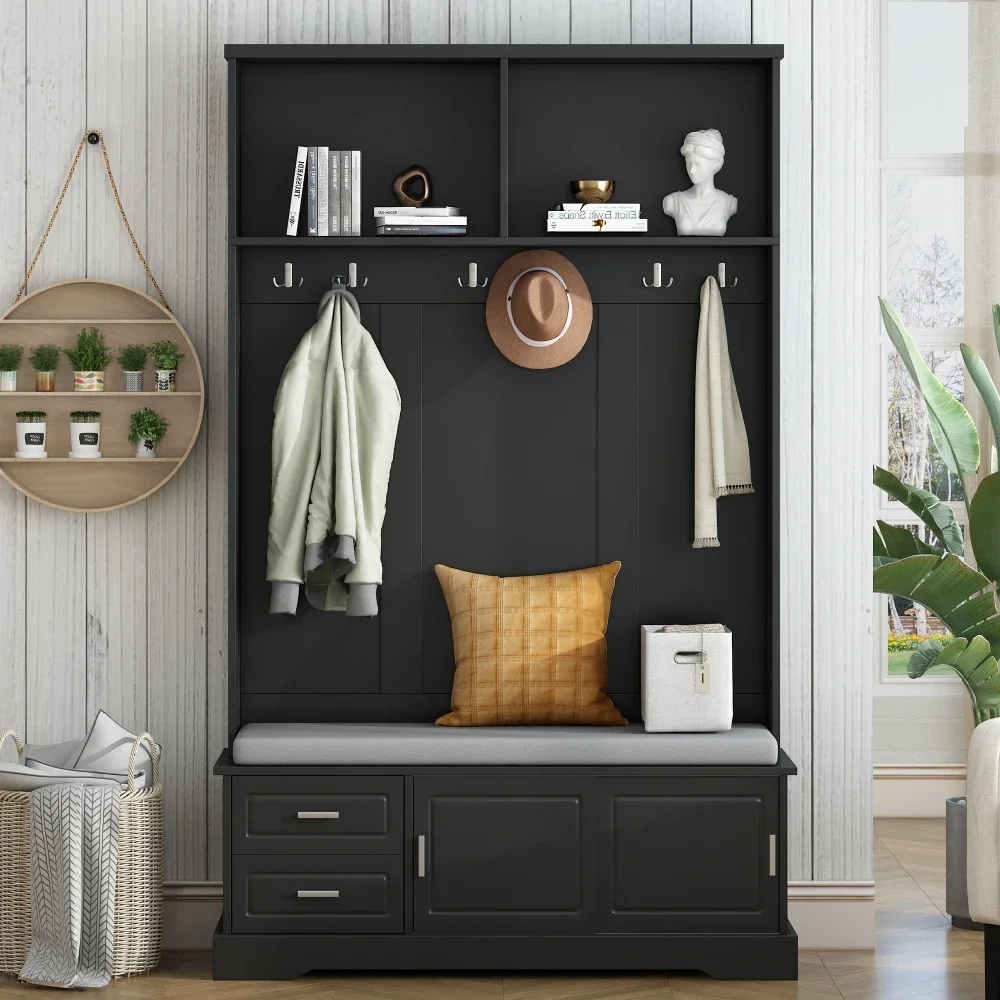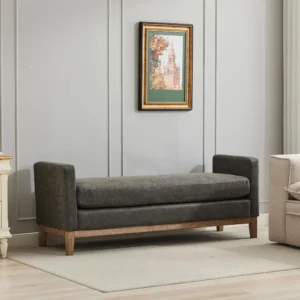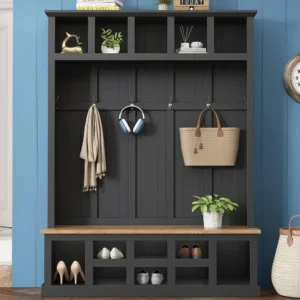Understanding the Value of Entry Benches with Hooks
The entryway is the first impression of your home—both for guests and for yourself when you return after a long day. Unfortunately, this space often becomes a chaotic collection of shoes, coats, bags, and other daily essentials. This is where entry benches with hooks come in as the unsung heroes of home organization.
These multifunctional furniture pieces serve several purposes simultaneously: providing a place to sit while putting on or removing shoes, offering storage for footwear and accessories, and creating a designated area for hanging coats, bags, and keys. The beauty lies in their ability to contain clutter while enhancing your home’s aesthetic appeal.
Research suggests that an organized entryway can significantly reduce morning stress levels, with some studies indicating that families save up to 15 minutes during morning routines when everyday items have designated places. Beyond mere convenience, these practical pieces maximize limited space—a valuable benefit considering that entryways are typically among the smallest areas of the home.
Before diving into specific options and organization strategies, it’s worth understanding how space-saving benches can completely transform your entryway from a stress-inducing jumble to a functional, welcoming space that sets the right tone for your entire home.
Selecting the Perfect Entry Bench with Hooks for Your Space
Finding the right entry bench with hooks begins with careful assessment of your space and needs. This foundational step ensures your chosen piece will serve your household effectively for years to come.
Start by measuring your entryway carefully:
* Width: Measure the available wall space where the bench will sit
* Depth: Determine how far the bench can extend into the space without impeding traffic flow
* Height: Consider ceiling height if looking at tall hall tree options
For most homes, an entry bench should leave at least 36 inches (91 cm) of walkway space to allow comfortable passage. In smaller apartments, you might need to consider narrow entryway benches that provide functionality without overwhelming the space.
Next, analyze your household’s specific needs:
* Family size: Larger households need more hooks and storage capacity
* Daily activities: Sports equipment, school backpacks, or work bags require different storage solutions
* Seasonal considerations: Bulkier winter items demand more substantial storage options
The aesthetic element matters too. The entry bench should complement your existing decor and set the tone for your home’s overall style. Consider whether you prefer modern minimalism, rustic farmhouse charm, or classic elegance.
Understanding the complete guide to choosing compact benches can help you navigate these important decisions while ensuring you select a piece that balances form and function for your unique space.
Types of Entry Benches with Hooks: Finding Your Match
Entry benches with hooks come in various designs, each offering different benefits depending on your space constraints and organizational needs.
Hall Trees act as complete entryway solutions, combining seating, hooks, and substantial storage in one unit. These coat rack benches typically feature a bench, multiple hooks, and often include additional storage like cubbies, cabinets, or shelves. They’re ideal for families needing maximum organization but require more substantial space.
Freestanding Benches with Hook Systems offer more flexibility in placement. These entryway coat rack benches provide essential hanging storage while maintaining a smaller footprint than full hall trees. They work well in moderate-sized entryways where organization matters but space remains limited.
Storage Benches with Hidden Compartments prioritize seating and concealed storage with hooks as a secondary feature. The hidden storage keeps shoes, scarves, and other items out of sight, creating a cleaner look—perfect for those who prefer minimalist aesthetics.
Slim-Profile Options are designed specifically for narrow hallways or small apartments. These space-savers might offer fewer hooks or less seating area but provide essential functionality without crowding tight spaces.
Built-in Custom Solutions involve customizing storage to fit unique spaces. While requiring more investment, they maximize every inch of available space and can be tailored precisely to your needs.
When comparing options, consider your primary needs: Is maximum hanging space for coats your priority? Do you need substantial shoe storage? Would hidden storage better suit your organizational style? The answers to these questions will guide you toward the perfect match for your entryway.
Material and Construction Considerations
The materials used in your entry bench significantly impact its durability, maintenance requirements, and how well it complements your home’s aesthetic. Since entryway furniture endures daily use and frequent contact with outdoor elements, quality construction becomes particularly important.
Wood Options:
* Solid hardwoods (oak, maple, walnut): Extremely durable but typically more expensive
* Pine and other softwoods: More affordable but may show wear more quickly
* Engineered wood: Budget-friendly with varying quality levels
Wood entryway benches offer timeless appeal and substantial durability when properly constructed. Look for solid joinery methods like dovetail or mortise-and-tenon connections rather than just glued joints for better longevity.
Metal Components:
* Steel: Provides maximum strength for hooks and structural elements
* Iron: Offers classic aesthetic appeal and excellent durability
* Aluminum: Lightweight and resistant to corrosion
Upholstered Elements:
* Performance fabrics: Stain-resistant and easy to clean
* Leather or faux leather: Durable and simple to wipe down
* Removable cushions: Allow for easier cleaning or replacement
Weight capacity matters significantly for entry benches. Quality options should support at least 250 pounds (113 kg) for seating, while hooks should each hold 10-15 pounds (4.5-6.8 kg) to accommodate heavy winter coats and loaded backpacks.
For households with children or pets, consider materials that resist scratching and are easy to clean. Similarly, if your entry receives direct sunlight, look for materials with UV-resistant properties to prevent fading over time.
Strategic Placement for Maximum Functionality
Where you position your entry bench can significantly impact both its utility and your entryway’s flow. Strategic placement transforms this furniture from merely useful to genuinely transformative for your daily routines.
When positioning relative to your entry door, aim to place the bench adjacent to or opposite the door rather than directly in front of it. This creates a natural flow into your home while providing immediate access to the bench’s functions. Ideally, allow 24-36 inches (61-91 cm) of clearance in front of the bench to enable comfortable seating and access to storage.
For challenging spaces like narrow hallways, consider these techniques:
* Corner placement to maximize unused space
* Wall-mounted hooks above a slim bench to utilize vertical space
* L-shaped configurations for awkward layouts
Traffic flow should be your priority—ensure the bench doesn’t create bottlenecks during busy mornings when multiple family members may be entering or exiting simultaneously. The ideal placement allows people to move freely while still having access to storage features.
Utilizing space-saving entryway ideas can help you work with architectural challenges like sloped ceilings, radiators, or existing built-ins. Sometimes, the most effective solution might involve customizing your approach rather than following conventional placement rules.

Organizing Coats and Accessories with Hook Systems
The hook system is arguably the most valuable feature of an entryway bench setup, but using it effectively requires thoughtful planning. Strategic organization of these hooks transforms them from simple pegs to a comprehensive system for managing your daily essentials.
Height Placement Guidelines:
* Adult-accessible hooks: Position at 5-6 feet (152-183 cm) from the floor
* Child-accessible hooks: Position at 3-4 feet (91-122 cm) from the floor
* Varied heights: Create a staggered pattern for visual interest and functionality
When organizing for multiple household members, consider dedicating specific hooks to each person. This creates accountability and reduces morning confusion. Some families benefit from color-coding systems using different colored hooks or tags to distinguish between individual users.
For weight distribution, follow these principles:
* Heavier items (winter coats) should be hung on hooks anchored directly to studs
* Limit weight to 10-15 pounds (4.5-6.8 kg) per hook to prevent damage
* Distribute heavy items across multiple hooks rather than clustering them
Consider specialized hook types for different items:
* Double hooks for multiple light items
* Deep hooks for purses and backpacks
* Small hooks for keys and accessories
* Decorative hooks that complement your home’s style
Many bench hooks and storage systems offer versatile options for customization. Look for adjustable or repositionable hooks that allow you to reconfigure your setup as seasons change or family needs evolve.
Maximizing Bench Storage: Beyond Just Seating
The space beneath and within your entry bench represents valuable real estate for organizing the items that typically create entryway clutter. Using this storage effectively doubles the functionality of your furniture piece.
Shoe Organization Strategies:
* Open shelving: Provides easy access but keeps shoes visible
* Cubbies: Offer separated spaces for each pair or family member
* Hidden compartments: Keep footwear concealed for a cleaner look
* Boot trays: Protect your bench from wet or muddy footwear
Most standard entry benches accommodate 4-6 pairs of shoes per person, though this varies by bench size and design. For households with extensive footwear collections, consider supplementary storage or rotating seasonal items.
Baskets and bins transform open storage into organized compartments:
* Small bins for gloves, scarves, and winter accessories
* Medium baskets for sports equipment or pet supplies
* Labeled containers for each family member’s items
* Attractive containers that enhance rather than detract from your decor
Seasonal rotation proves essential for maximizing limited space. Store off-season items in less accessible areas (like under-bed containers) while keeping current-season necessities within easy reach.
For tiny entryways, best small benches for entryways can provide surprisingly effective storage despite their compact footprint. Similarly, entryway bench storage solutions often include clever compartments that maximize every available inch.

Creating Designated Zones for Family Members
Establishing individual zones within your entry bench system transforms personal organization from a suggestion to a household habit. This approach reduces morning chaos and helps maintain long-term order.
For families, consider these organizational approaches:
* Assigned hooks with name tags or distinct decorative elements
* Color-coded baskets corresponding to each family member
* Divided cubbies marked for individual use
* Height-appropriate storage zones for different age groups
Children benefit particularly from clearly designated spaces. Position their hooks, baskets, and storage at accessible heights (typically 2-3 feet/60-90 cm from the floor) and consider adding picture labels for pre-readers. This early organization system teaches responsibility while making mornings smoother.
Guest accommodation deserves consideration too. Designating a specific section of your entry bench system for visitors makes them feel welcome while preserving your family’s established organization. A simple “Guest” hook and small basket for temporary items creates this dedicated space.
Many families find that organizing a small entryway bench efficiently improves their entire morning routine. When everyone knows exactly where their items belong, the frantic search for keys, gloves, or backpacks becomes a thing of the past.
Entryway Bench with Cushion, Mudroom Bench with Cushion, Shoe Bench for Entryway
$1,186.63 Select options This product has multiple variants. The options may be chosen on the product pageCoat Rack Shoe Bench, Corner Entryway Bench, Corner Hall Tree, Shoe Bench for Entryway
$313.58 Select options This product has multiple variants. The options may be chosen on the product pageCorner Entryway Bench, Entryway Bench with Cushion, Modern Entryway Bench, Shoe Bench for Entryway
$476.34 Select options This product has multiple variants. The options may be chosen on the product pageBench with Hooks and Storage, Entryway Hall Tree, Mudroom Bench with Cubbies, Mudroom Bench with Shoe Storage
$818.38 Select options This product has multiple variants. The options may be chosen on the product pageModern Entryway Bench, Wood Entryway Bench, Wood Mudroom Bench
$497.69 Select options This product has multiple variants. The options may be chosen on the product pageEntryway Coat Rack Bench, Entryway Hall Tree, Farmhouse Mudroom Bench, Mudroom Bench with Shoe Storage
$805.09 Select options This product has multiple variants. The options may be chosen on the product page
Styling Your Entry Bench Area for Both Function and Appeal
Your entry bench doesn’t have to sacrifice style for functionality. The most successful entryways manage to balance practical organization with aesthetic appeal, creating a space that’s both useful and visually welcoming.
When styling your entry bench area, embrace these principles:
* The Rule of Three: Group decorative items in threes for visual harmony
* Varied Heights: Include elements of different heights for visual interest
* Balanced Asymmetry: Create deliberate arrangements that feel intentional but not rigid
Cushions and textiles add both comfort and style to entry benches. Entryway bench cushions in durable, stain-resistant fabrics provide comfortable seating while introducing color and texture. Consider selecting cushions that can be easily removed for cleaning or seasonal changes.
Seasonal decor creates a dynamic entryway that evolves throughout the year:
* Spring: Fresh flowers, light textiles, nature-inspired elements
* Summer: Coastal touches, bright colors, outdoor-themed accessories
* Fall: Warm tones, textural elements, subtle harvest touches
* Winter: Soft lighting, cozy textiles, festive accents
Lighting transforms both the function and atmosphere of your entry area. Consider wall sconces beside or above your bench, a small lamp if surface space allows, or overhead lighting that adequately illuminates the area for practical use while creating a welcoming ambiance.
The key is maintaining equilibrium—your styled entry bench should remain primarily functional with decorative elements enhancing rather than impeding its practical purpose.
Complementary Elements to Enhance Your Entry Bench Setup
The right complementary pieces elevate your entry bench from a standalone storage solution to a comprehensive entryway system. These additional elements work together to create a more functional, organized, and welcoming space.
Wall-mounted additions maximize vertical space:
* Mirrors positioned at eye level (approximately 5-6 feet/152-183 cm high) create the illusion of more space while serving the practical purpose of last-minute appearance checks
* Additional shelving above benches provides display space for decorative items or extra storage
* Wall-mounted mail organizers keep important papers from creating clutter
* Key hooks positioned near eye level prevent frantic searches during departures
Floor protection becomes essential for preserving both your floors and bench:
* Weather-resistant mats catch dirt and moisture before they enter your home
* Boot trays contain melting snow or mud from outdoor footwear
* Washable rugs add style while protecting flooring
Lighting deserves careful consideration:
* Motion-activated options illuminate the space when you enter with arms full
* Warm-temperature bulbs create a welcoming ambiance
* Adequate brightness ensures safety and functionality
Many homeowners discover that versatile benches with hooks can be further enhanced with these thoughtful additions. The goal is creating a cohesive system where each element serves both practical and aesthetic purposes without overcrowding the space.
Maintaining Organization: Daily and Seasonal Systems
Even the most thoughtfully designed entry bench system requires ongoing maintenance to remain functional. Establishing simple routines prevents the natural tendency toward clutter accumulation.
Daily Reset Routine (5 minutes):
* Return items to designated hooks and storage areas
* Clear the bench surface of any accumulated items
* Return shoes to their proper storage location
* Hang coats and bags on appropriate hooks
Weekly Organization Check (15 minutes):
* Remove items that don’t belong in the entryway
* Wipe down surfaces to remove dust and dirt
* Check for items that need to be washed or cleaned
* Ensure all storage containers remain properly positioned
Seasonal transitions require more substantial reorganization:
* Remove out-of-season items for storage elsewhere
* Clean all surfaces thoroughly during the transition
* Assess storage needs for the upcoming season
* Adjust hook heights or storage configurations as needed
For the bench itself, regular maintenance preserves both function and appearance:
* Wood surfaces: Dust weekly and apply appropriate polish quarterly
* Metal components: Check for stability and tighten any loose screws
* Upholstery: Vacuum or spot-clean as needed
* Hooks: Test regularly for security, especially when supporting heavier winter items
These maintenance routines ensure your entry bench continues functioning efficiently while maintaining its aesthetic appeal throughout years of daily use.
Solving Common Entryway Challenges with Smart Bench Setups
Even the most challenging entryway layouts can be improved with thoughtful bench configurations. These targeted solutions address specific problems that might otherwise make entryway organization seem impossible.
Challenge: Extremely Limited Space
Solution: Consider wall-mounted fold-down options that provide bench functionality only when needed. Alternatively, explore space-saving entry benches for small homes that are specifically designed with minimal footprints while maintaining essential functions.
Challenge: Weather Exposure
Solution: For entries exposed to outdoor elements, choose water-resistant materials like treated wood or metal. Incorporate additional protection like covered boot trays and water-resistant mats to contain moisture from rain or snow.
Challenge: High-Traffic Durability Concerns
Solution: Select commercial-grade construction with reinforced joints and scratch-resistant finishes. Look for benches with replaceable parts, particularly for elements that receive the most wear like cushions or shoe racks.
Challenge: Multi-Generational Household Needs
Solution: Create a tiered organization system with lower hooks for children and elderly family members, mid-level storage for everyday access, and higher hooks for less frequently used items. Include seating with supportive backs and arms for those who need assistance when removing or putting on footwear.
Challenge: Tiny Apartments with No Defined Entry
Solution: Use slimline vertical storage units that maximize wall space while minimizing floor footprint. Consider dual-purpose furniture like storage ottomans that can move between entry functions and living room seating as needed.

Can Entry Benches with Hooks Work in Open Floor Plans?
Open floor plans present unique challenges for entry organization since there’s often no defined entryway. However, with strategic placement and thoughtful selection, entry benches with hooks can actually help define these spaces while providing essential organization.
Creating a “virtual entryway” in an open concept home involves using your bench as a room divider. Position it perpendicular to your entry door to establish a visual boundary between the entrance area and the rest of your living space. This placement creates the impression of an entryway where none architecturally exists.
Taller hall tree systems work particularly well in open concepts, as their height establishes a vertical boundary. These pieces effectively create the sense of a separate space while maintaining the open feel that makes these floor plans desirable.
For visual integration, select bench materials and finishes that complement both your door/entry area and the adjacent living space. This creates a transitional element that bridges different functional zones while maintaining design cohesion throughout the open area.
The key to success lies in selecting a piece with appropriate scale—too small, and it won’t effectively define the space; too large, and it may disrupt the open feeling you want to preserve.
How to Adapt Entry Bench Systems for Seasonal Changes?
Seasonal transitions demand different things from your entry bench system. Adapting your setup throughout the year ensures it remains functional regardless of weather conditions or household activities.
Winter Organization:
* Maximize hook capacity for bulky coats and snow gear
* Add boot trays for wet, salty footwear
* Incorporate baskets for gloves, scarves, and hats
* Consider temporary additional hooks during peak winter months
Summer Configuration:
* Reduce hook usage for lighter jackets and sun hats
* Repurpose some storage for outdoor activity gear
* Create space for beach bags, sports equipment, and gardening tools
* Add breathable mesh containers for quick-dry items
Spring and Fall Transitions:
* Implement a gradual rotation system as weather changes
* Maintain flexible storage for unpredictable weather items
* Use vacuum storage bags for off-season gear being removed
* Keep some all-season items accessible year-round
For holiday preparation, consider how your entry bench will accommodate guests:
* Create temporary additional hanging space using removable hooks
* Clear personal items to make room for visitor belongings
* Ensure seating remains accessible for guests removing footwear
* Add seasonal decor that doesn’t interfere with functionality
These adaptations ensure your entry bench serves your household needs consistently throughout the year, regardless of external conditions or special occasions.
Is a Custom Entry Bench Solution Right for Your Home?
While pre-made entry benches offer convenience and immediate solutions, custom options provide tailored functionality for unique spaces or specific household needs. Understanding when to invest in customization helps make this important decision.
Consider custom solutions when:
* Your entryway has unusual dimensions or architectural features
* Standard sizes consistently fail to meet your storage needs
* You have specific aesthetic requirements matching existing woodwork
* Your household has unique organizational challenges
The cost difference between quality pre-made and custom options varies significantly, with custom pieces typically costing 30-100% more. However, this investment often delivers precisely what your space needs without compromise.
DIY customization offers a middle-ground approach:
* Adding additional hooks to standard benches
* Building custom storage inserts for bench compartments
* Painting or refinishing to match your decor
* Combining multiple pieces for a built-in appearance
Working with professionals for built-in solutions makes sense when permanent, architecturally integrated storage would significantly improve your entryway function. Though the most expensive option, these custom installations often add home value while providing exactly the organization system your household needs.
The decision ultimately balances your budget, timeline, and specific requirements—with the understanding that the perfect entry bench system is one that seamlessly supports your daily routines while enhancing your home’s functionality and appeal.







